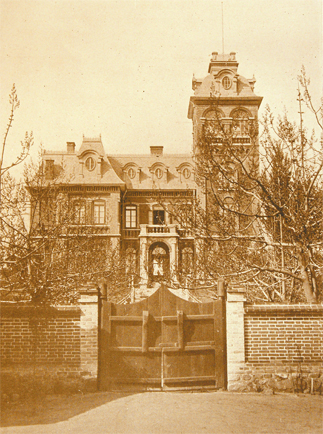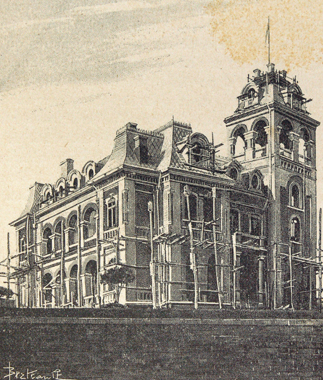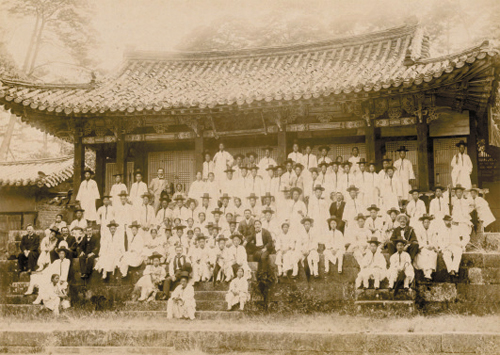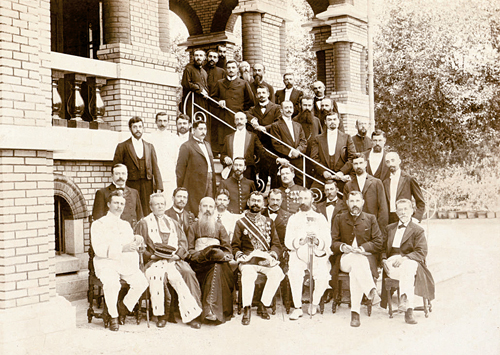Cornerstone of relations with France

The French legation compound once stood on the grounds of Changdeok Girls’ Middle School in Jeong-dong.
The cornerstone is, in fact, all that’s left of the original French legation. As can be seen in the main photo, the building was a two-story, red-brick French baroque structure. The building was widely photographed and appeared in “The Passing of Korea” (1906), written by Homer Hulbert (1863-1949), an American missionary in Korea, and several foreign publications on Korea between the late 19th and early 20th centuries.
Architectural historians note that although the building was designed in a Western architectural style, the gate had traditional Korean characteristics. Some even say the French legation was the most beautiful among the legations erected in Korea in the late 1900s.
Missionaries and invasion
Embassy documents trace Korea-France relations to 1787, when the French first discovered the existence of the Joseon Dynasty (1392-1910). They have argued that France was the first Western country to lay eyes on the hermit kingdom.
But judging from the incidents that followed, it’s hard to say that relations between Korea and France began well.
French Catholic missionaries began coming to Korea in the early to mid-19th century, proselytizing to a growing Korean flock. It is widely believed that the first French missionary to come to Korea was Pierre Philibert Maubant (1803-1839), although some historical records assert that there was another French missionary who arrived earlier.

Construction of the legation was completed in 1896, as the school’s cornerstone indicates. Provided by Myongji University-LG Yeonam Library
In 1866, Heungseon Daewongun (1820-1898), the father of King Gojong (1852-1919), ordered the execution of Catholics in the country, including French missionaries. The Daewongun, a keen advocate of Korea’s isolationist policies, was trying to shut Korea off from Western influences and beliefs. Nine French missionaries were executed. This incident led to the French campaign against Korea, known here as Byeong-in yangyo, which was carried out in 1866 in retaliation for the missionaries’ deaths. During the month-long conflict, French troops plundered weapons, food and artifacts.
What the French took from Korea then is still making headlines today. Uigwe, or the Royal Protocols of the Joseon Dynasty, which was taken during the French campaign, is currently being kept in the National Library of France. Korea has tried to repatriate the documents for years, but to no avail. In 2007, Korea applied and won a place for Uigwe in the United Nations Educational, Scientific and Cultural Organization’s Memory of the World Register.
Beginnings and endings
Korea and France established diplomatic ties on June 6, 1886. The following year, France dispatched its first French consul and minister, Victor Collin de Plancy (1853-1924), to Korea.
When de Plancy arrived, he founded the mission in a traditional Korean house, but two years later he decided that a new building was needed.
According to Kim Jeong-dong, architectural history professor at Mokwon University, the site de Plancy chose was once the home of a high-ranking government official close to King Taejong (1367-1422). Kim believes that the house of an official named Hwang Yun-gil used to be on the site and that others who shared Hwang’s political ideas also occupied the area.

Martel and his students at the French school in 1901.
“The building’s distinctive feature was the tower,” Kim says. “It was five stories high, the tallest structure in the area at that time.”
According to the book, “En Coree” (1904) by French archeologist Emile Bourdaret, de Plancy often threw garden parties at the French legation, including a chrysanthemum festival held every autumn.
After the Japan-Korea Protectorate Treaty in 1905, the French mission in Korea was downgraded to a consulate.
After the Japanese invasion of Korea began in 1910, it moved to Hap-dong, Seodaemun District. Records show that the French legation in Jeong-dong was vacant for some time, which earned it the nickname “Ghost House.” It was used by the Japanese for other purposes, before they demolished it in 1935.
Courant and Martel
Two other Frenchmen were influential in early Korea-France relations.
Maurice Courant (1865-1935) came to Korea in 1890 as an interpreter and secretary for the French legation. During his two-year stay, Courant, with the support of de Plancy, wrote “Bibliographie Coreenne” from 1894 until1901, three volumes documenting some 3,821 Korean books. The publication paved the way for Korean studies abroad and earned Courant a place in history as the father of Korean studies in Europe.

French residents in Korea were invited to a celebration held at the French legation in 1903 to celebrate Bastille Day. Provided by the French Embassy in Korea, courtesy of MAEE/DCP
Emile Martel (1874-1949) arrived in Korea when the Korean government made a regulation on foreign schools in May 1895. Five months later, a French-language school opened in front of the French legation with the purpose of educating Korean diplomats. Martel, a customs officer who was in Shanghai, China, was called in to serve as the school’s principal and a teacher, at de Plancy’s recommendation.
Martel was forced to leave Korea after Japan invaded Korea in 1910. But he came back to the country in 1920 and taught French at Gyeongseong Imperial University (now Seoul National University). Martel was forced to go to China during World War II, but he returned to Korea after the country’s liberation in 1945. He died in Korea in 1949.

By Kim Hyung-eun [hkim@joongang.co.kr]










with the Korea JoongAng Daily
To write comments, please log in to one of the accounts.
Standards Board Policy (0/250자)